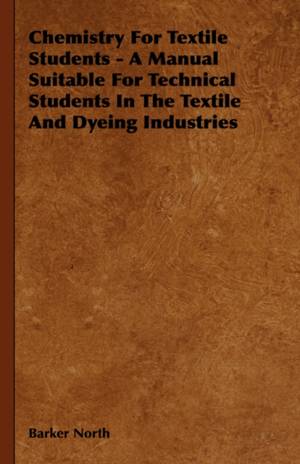
- Retrait gratuit dans votre magasin Club
- 7.000.000 titres dans notre catalogue
- Payer en toute sécurité
- Toujours un magasin près de chez vous
- Retrait gratuit dans votre magasin Club
- 7.000.000 titres dans notre catalogue
- Payer en toute sécurité
- Toujours un magasin près de chez vous
Chemistry for Textile Students - A Manual Suitable for Technical Students in the Textile and Dyeing Industries
Barker North
Livre relié | Anglais
59,95 €
+ 119 points
Description
The present time, being one of reconstruction, is an opportune moment for the presentation of this work, as it is, we believe, the first attempt to put forward a fairly complete course on "Chemistry for Textile Students" suitable for the large and growing number of students who are taking up the technical study of textile industries from the truly scientific standpoint. It is a noteworthy feature of the last "Census of Production," published in 1907, that, if we omit coal mining, whilst the cotton and woollen industries occupy respectively the first and fourth positions among the nine leading industries of the country as regards number of people employed, yet these industries employ a smaller percentage of well-trained technologists than any of the others. With one exception, the productivity, or net output in value per head of persons employed, is less in the case of textile industries, apart from chemistry and dyeing, than that of the other great industries of the country, and this is no doubt largely due to the small percentage of well-trained technologists employed. Apart from the branches of bleaching and dyeing, it is only in very recent years that it has been realised, and only then by the most enlightened employers, that chemistry and physics play a most important part in the various operations used in the production of yarns and finished pieces. Recently, however, it has been recognised that Germany, in pre-war times, was getting far ahead of us, principally through the, direct application of the sciences of chemistry, physics, and engineering to the processes of manufacture of textiles. Large manufacturers are now beginning to realise that specially trained textile-chemists and textile-engineers must be engaged for special research work, if progress is to be made which will enable us to keep pace with the competition of other great nations of the world. Germany was setting the pace in pre-war times, whilst our manufacturers were resting largely on the laurels of the past, with the result that certain branches of our great textile industry were fast passing to the continent; but in the near future other great nations of the world will have profited by the experience of Germany, and, if we are to maintain the traditions of the past, we must bring the sciences of chemistry and physics to bear to a greater degree on the study of textiles. It is a necessary part of the training of the textile technologist, who will later be engaged in the production of yarns and finished articles, that he should have received a thorough grounding in the sciences of chemistry and physics. These subjects, as recognised by the Board of Education in pamphlets recently published, should form constituent parts of every technical systematic course of study for textile students. This is not often the case in evening courses at the present time, probably on account of the short time available in purely evening work, but with the introduction of day continuation schools more progress on sound scientific lines should be possible. Although the scope of the work has been made fairly wide, so as to be generally useful to students in the textile and dyeing industries, the teacher of chemistry for textiles will have no difficulty in adapting the work to any special course suitable for students in cotton manufacture, woollen and worsted manufacture, dyeing, etc., and from the nature of the work he will know what parts may be omitted or dealt with more briefly.
Spécifications
Parties prenantes
- Auteur(s) :
- Editeur:
Contenu
- Nombre de pages :
- 392
- Langue:
- Anglais
Caractéristiques
- EAN:
- 9781443732062
- Date de parution :
- 04-11-08
- Format:
- Livre relié
- Format numérique:
- Genaaid
- Dimensions :
- 140 mm x 216 mm
- Poids :
- 644 g







